
Santissima Annunziata Square or Holy Annunciation Square (Piazza della Santissima Annunziata) is one of the public squares of Florence, which, thanks to its harmonious ensemble of buildings and sculptures, is a unique pearl of the Italian Renaissance, and which is surrounded by several impressive buildings.
The square was formed over several centuries (starting from the 13th century), during which some of the greatest architects of the Renaissance took part in the construction of the square: Giambologna, Pietro Tacca, Michelozzo, Brunelleschi and others.
Today, the Santissima Annunziata Square demonstrates a unified character with a magnificent stylistic harmony of buildings, with arcades on three sides and with twin buildings on the fourth side of the square.
Among the Florentine squares, this square best expresses the ideals of the Renaissance city.
Today, the buildings on the square have a beautiful historical basilica, museums, a panoramic cafe and accommodation facilities (hotels, apartments)
The square is located in the historical center of Florence, just 400 meters from the main square of Florence - Piazza del Duomo, which is the heart of the city.
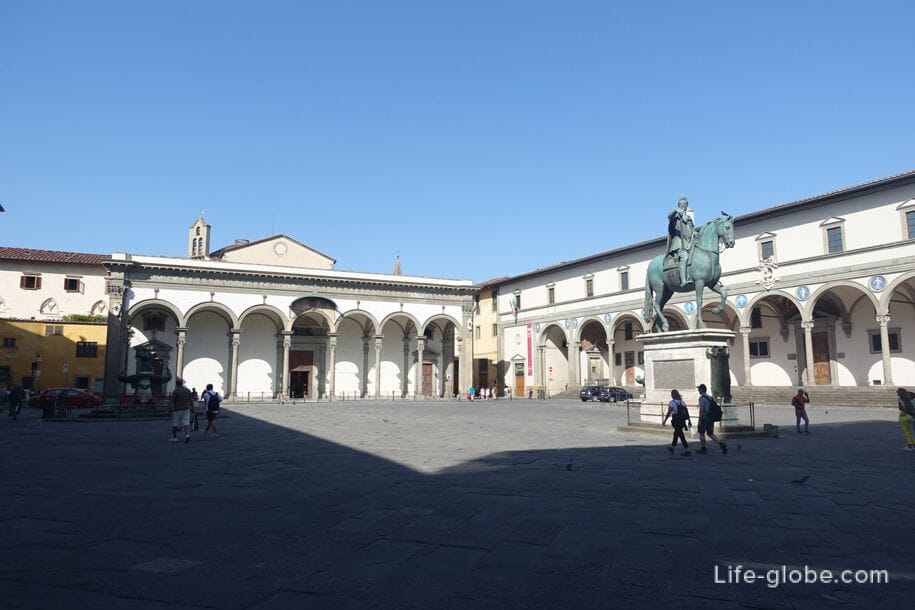
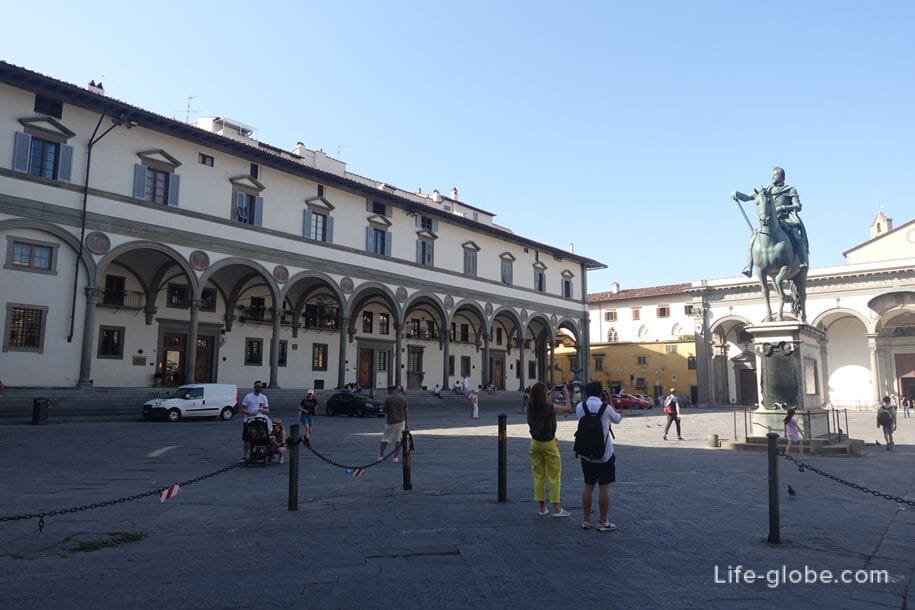
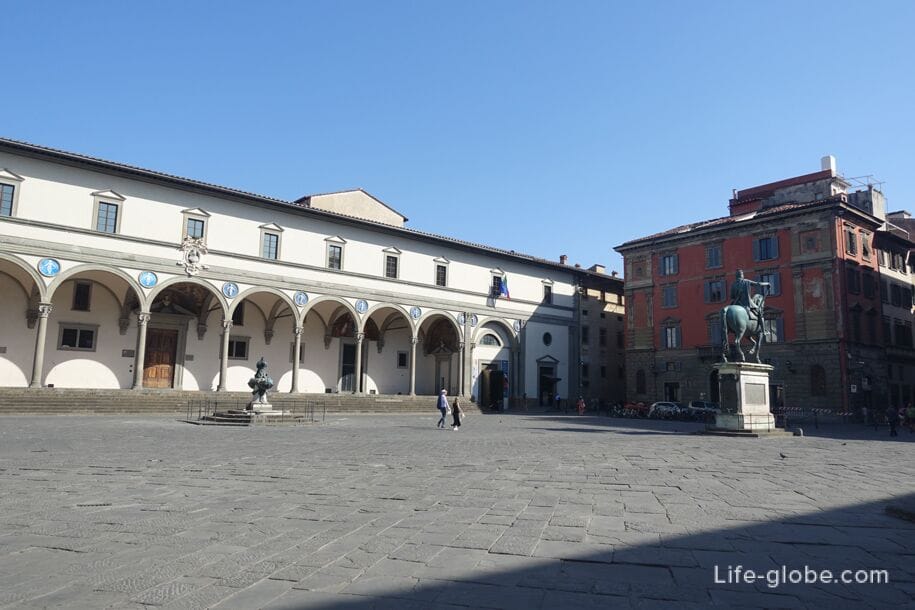
The center of the square of the Most Holy Annunciation is decorated with a monumental equestrian monument to Grand Duke Ferdinando I de' Medici.
This is one of the last works of the sculptor Giambologna, completed by his pupil Pietro Tacca, after Giambologna's death. The monument was commissioned by Cosimo II de' Medici (son of Ferdinando I), as a symbolic culmination of Duke Ferdinando I's dream of being remembered for his exploits, like his father Cosimo I de' Medici, to whom he dedicated a similar statue several decades earlier, also by Giambologna, but located in Piazza della Signoria in Florence.
The monument on a high pedestal was inaugurated in October 1608 on the occasion of the marriage of Cosimo II with Maria Maddalena d'Austria.
The monument was cast from the bronze cannons of Turkish galleys, won by the knights of the Military Order of Santo Stefano.
The Grand Duke is depicted in the monument sitting astride a frisky steed. Ferdinand is wearing a cuirass, with the cross of Santo Stefano clearly visible on his chest, an equestrian order established by Cosimo I the Elder.

Not far from the statue, on the sides of the square near buildings with arcades, two fountains "Sea Monsters" (Fontane dei mostri marini), considered masterpieces of the Mannerist style, are placed opposite each other.
The fountains were created in 1629 by Pietro Takii with the collaboration of students Bernardino Radi and Francesco Maria Bandini. The fountains were originally supposed to complement the monument to Ferdinand I of Livorno in Livorno, but they aroused the admiration of Grand Duke Ferdinando II de' Medici and therefore he ordered them to be placed in the center of Florence's Most Holy Annunciation Square. The fountains were installed in 1641.
The fountains are made in the form of marine elements: shells, fish, imaginary monsters, sea gargoyles, garlands with crustaceans and algae, masks.
Fountain on the east side of the square
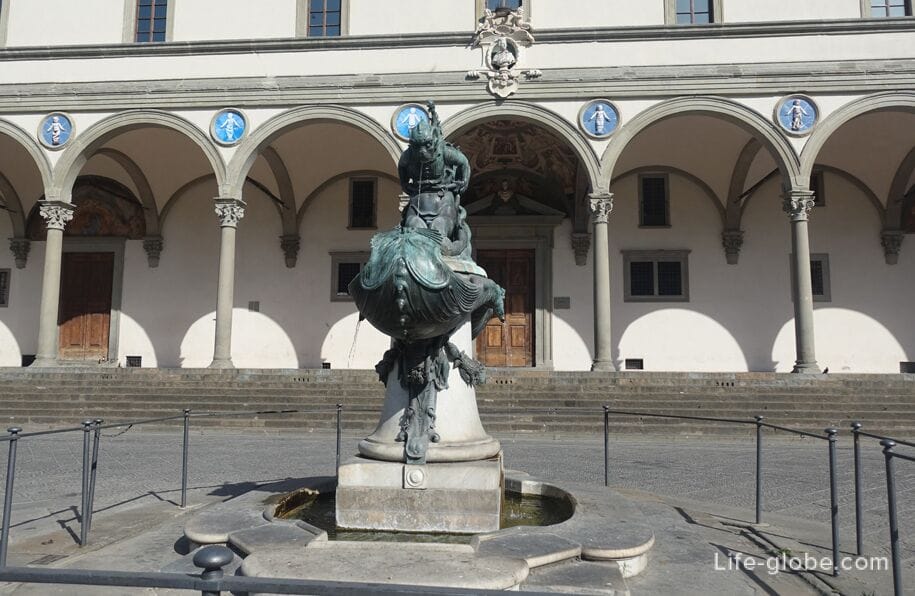
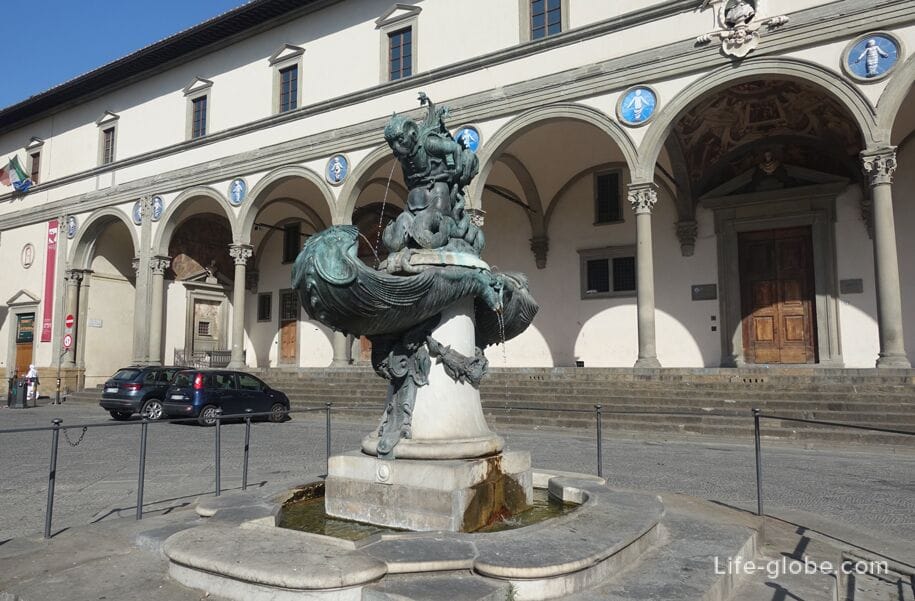
Fountain on the west side of the square
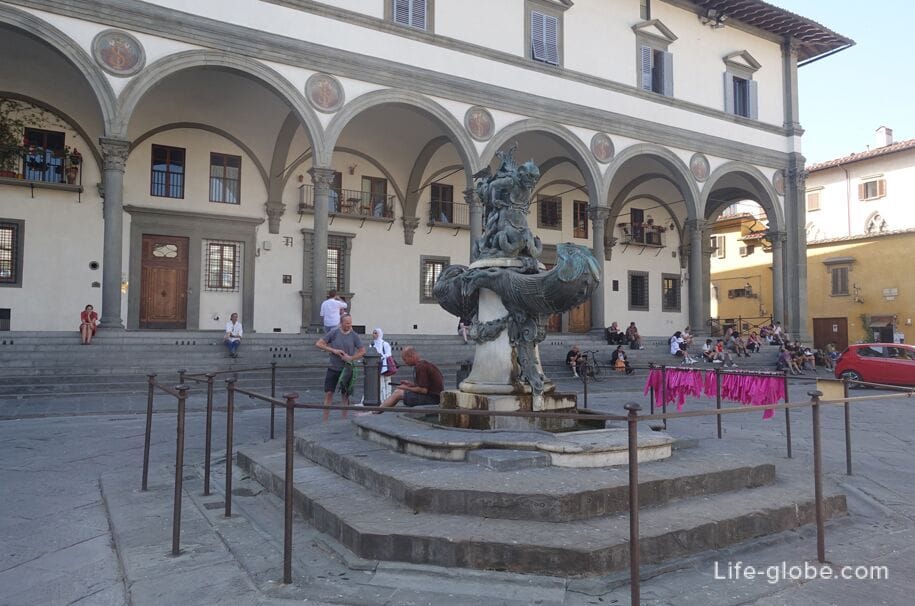

On the north side of the square of Santissima Annunziata is its main dominant - the Basilica of Santissima Annunziata (the Most Holy Annunciation, Santissima Annunziata), which looks at first glance does not look like a church at all.
This basilica is one of the most important sacred buildings in Florence, as well as the main sanctuary of Mary in the city and the mother house of the Order of Servants of Mary (L'Ordine dei servi di Maria).
Originally built on the site of an oratory traditionally founded in 1233 by seven young Florentines who founded the Order of the Servants of Mary in honor of the Virgin, the current basilica was rebuilt by Michelozzo in 1444 with numerous interventions after the seventeenth century.
So, in 1601, the Italian sculptor and architect Giovanni Battista Caccini added to the basilica a loggia (the narthex of the basilica) with an arcade on columns, in imitation of similar loggias that already existed on the square.
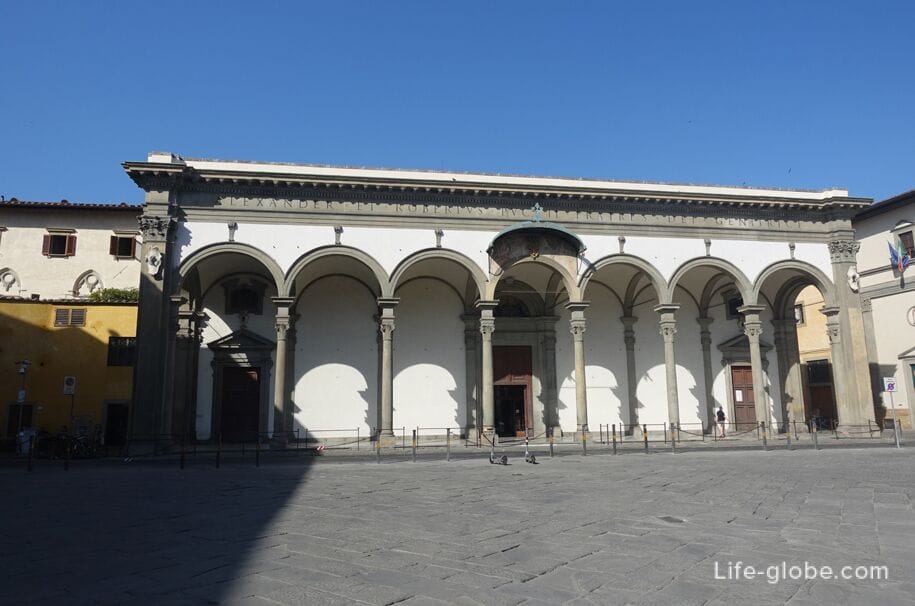
The interior of the basilica has a beautiful atrium with frescoes. The basilica itself impresses with the richness of Baroque decoration, with an altar, exquisite choirs, organs, chapels, frescoes, paintings, medallions and sculptural decorations.
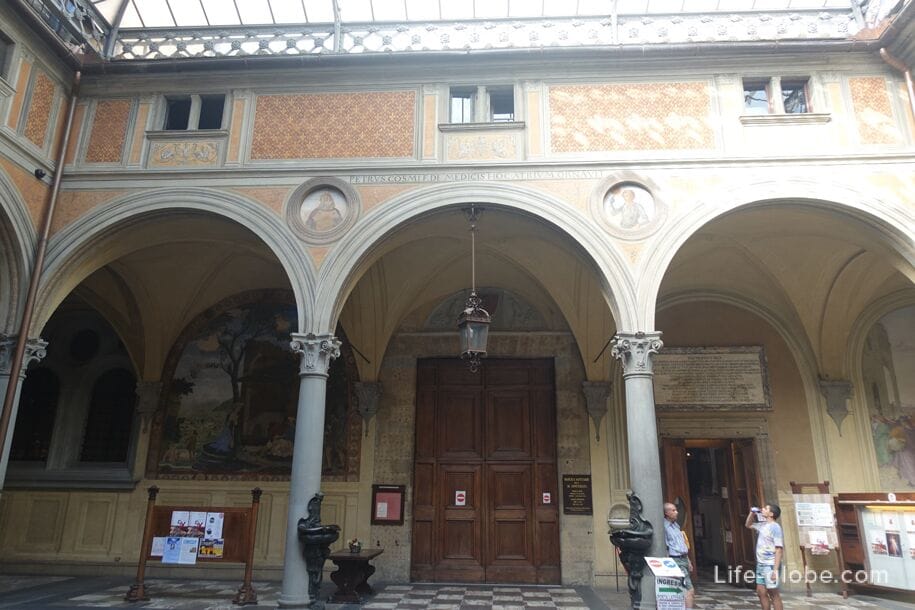
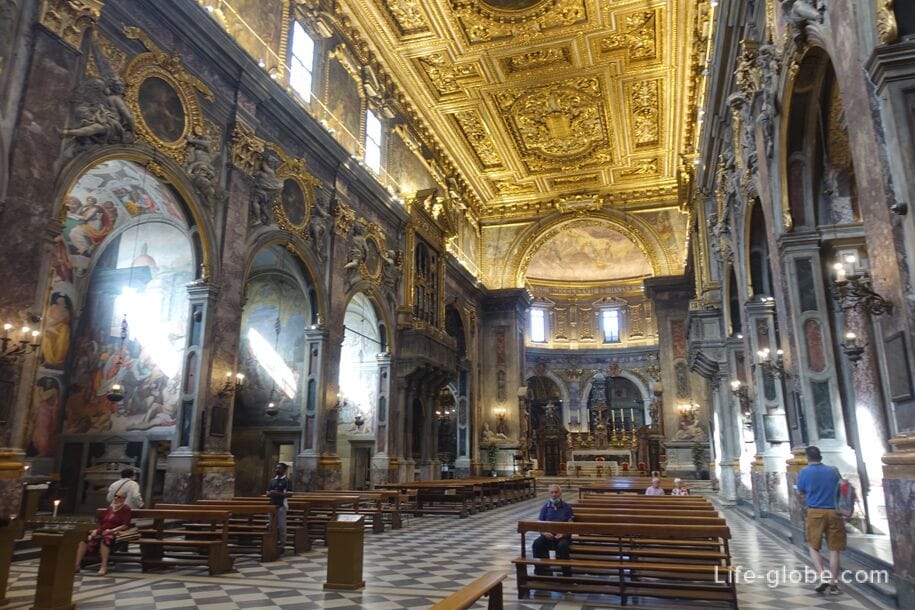
The most valuable in the basilica is the altar with the magnificent fresco "Annunciation" of the 14th century with the image of Maria Santissima Annunziata (from which the basilica got its name, and then the whole square). More about the Basilica of Santissima Annunziata…
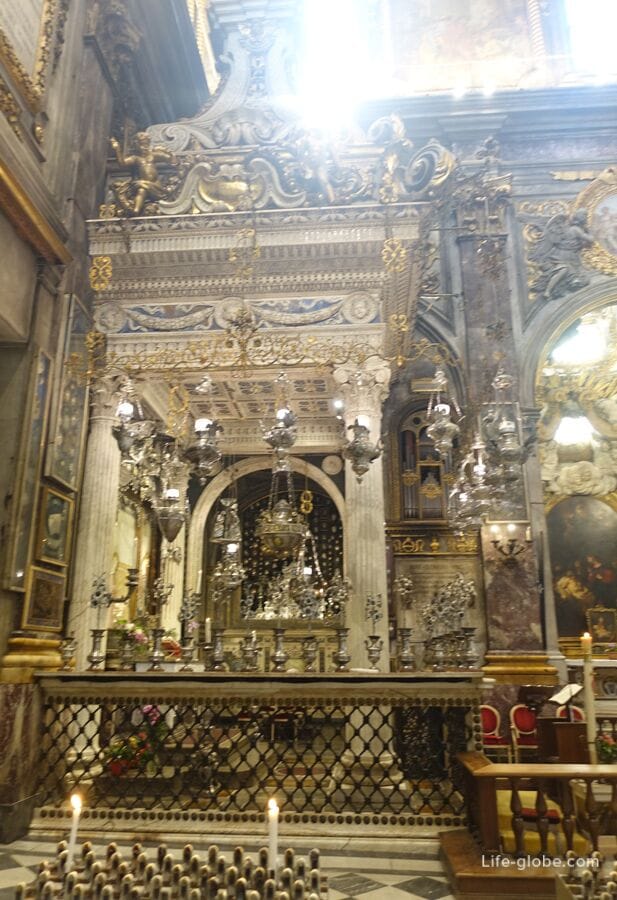

The basilica is part of the monastery complex and is connected on the right by a covered hinged arch-passage, built by architect Giulio Parigi, with the Crocetta Palace (Palazzo della Crocetta), built in 1619-1621 to accommodate Princess Maria Maddalena de' Medici, sister of Grand Duke Cosimo II, who was in poor health (possibly with mental retardation), and to she could safely go to mass without going down to the street, because it was difficult for her to climb stairs, and also so as not to attract the eyes of strangers.
At the end of the corridor, a small room with a lattice was built, from where a woman could watch the masses in the basilica. This corridor is called the "corridor of Maria Maddalena Medici" (Cavalcavia di Maria Maddalena de' Medici).

Today, the former Crocetta Palace with a garden houses the National Archaeological Museum of Florence (Museo Archeologico Nazionale di Firenze).
The museum was opened in 1870 by King Victor Emmanuel II. Initially, the exhibits of the museum were Greek and Roman antiquities from the family collections of the Medici and Lorena dynasties. Gradually, the collections were supplemented and expanded, including the Egyptian Collection.
The museum contains the best excavation materials from all over Tuscany, finds from Lazio and Umbria, with important Etruscan and Roman finds, as well as collections related to other civilizations, such as the Egyptian section and one of the Greek vases, many of which were found in Etruscan tombs, indicating numerous trade routes in the Mediterranean.
Entrance to the museum is paid. Museum website: firenze-maf-museo-archeologico-nazionale.
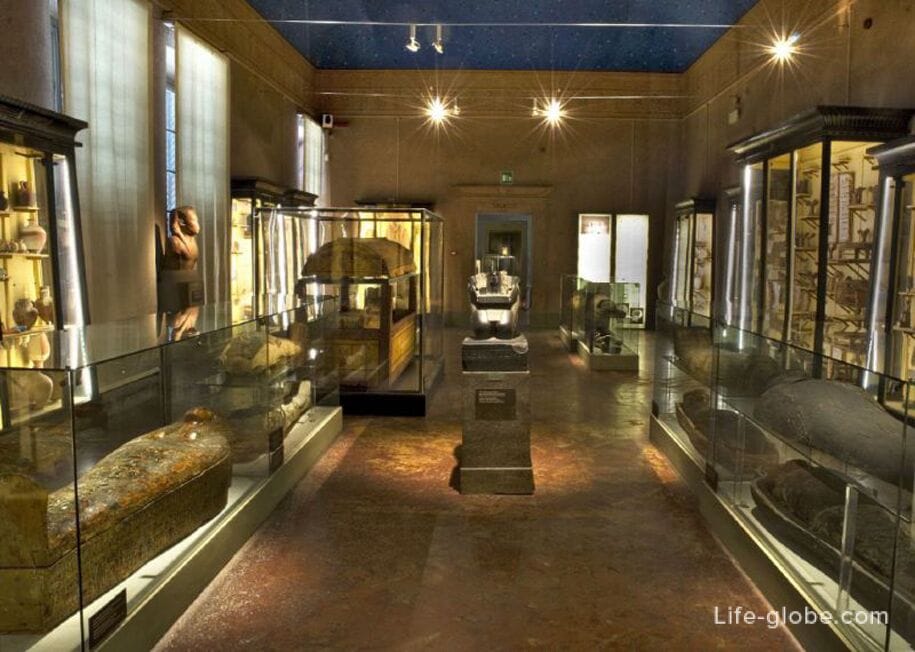
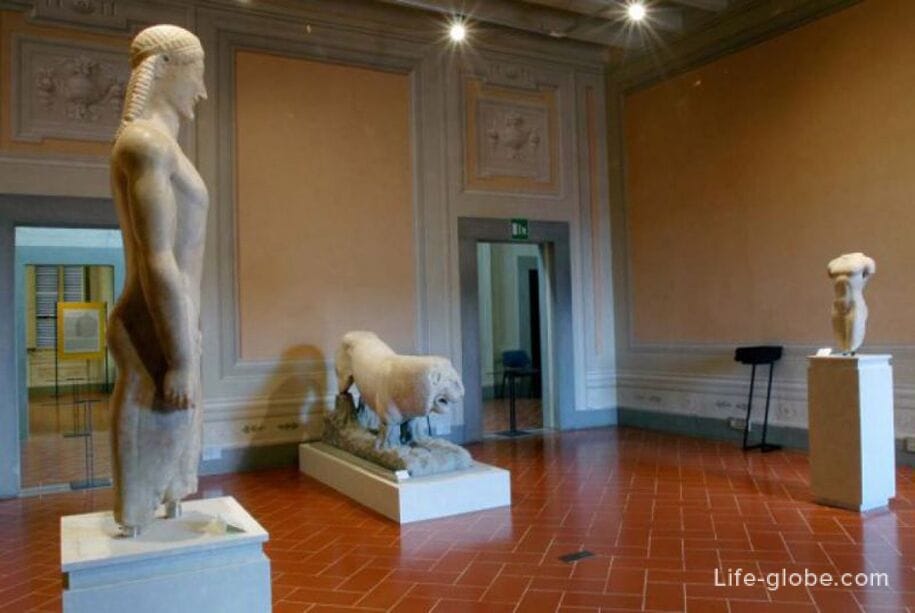
The eastern side of the Santissima Annunziata Square is formed by the complex of the Orphanage or Orphanage of the Innocents (Ospedale degli Innocenti, Ospedale degli Innocenti).
This is a former shelter for abandoned (homeless) children, built in the first half of the 15th century (since 1419) by architect Filippo Brunelleschi. The orphanage was the first European orphanage and is the first building in the Renaissance style, which marked the beginning of the Italian Renaissance in Florence.
Today it is a complex of the Institute of the Innocents (istituto degli Innocenti) with a beautiful exterior portico with frescoes, busts of the Medici and a window for foundlings, courtyards, a library, a church, a museum of the Innocents and a panoramic cafe that you can visit. More about the Orphanage, museum, cafe and church…
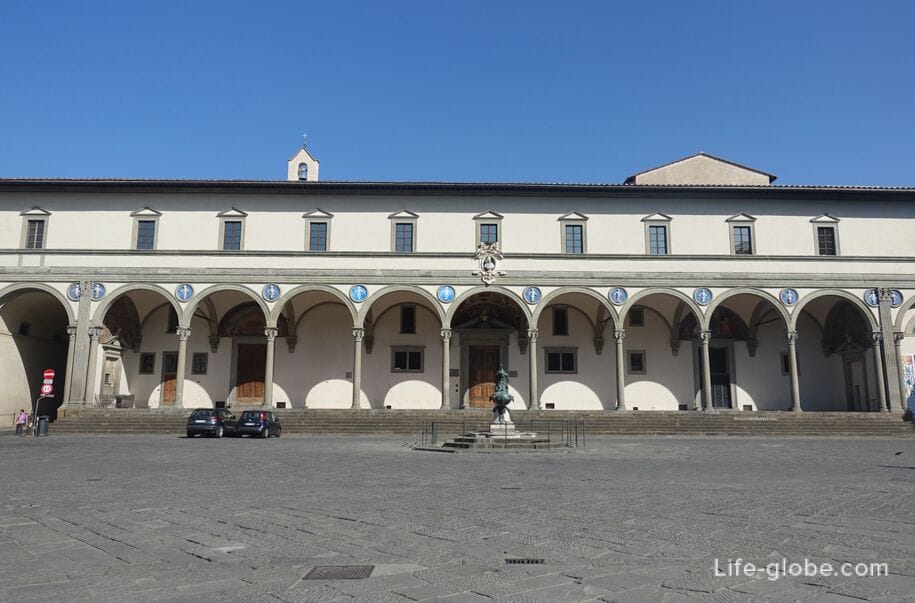


On the opposite (western) side of the square from the Orphanage is the beautiful Loggia of the Servants of Mary (Loggiato dei Servi di Maria), also known as the Loggia Serviti (dei Serviti).
The loggia was built between 1516 and 1525 by Antonio da Sangallo the Elder and Baccio d'Agnolo (worked on the loggia until 1519), in harmony with the architecture of the lodge of the Foundling Home.
The loggia was commissioned by the Order of the Servants of Mary, associated with the Basilica of Santissima Annunziata, as a suitable element to give unity to the square, and as a portico to connect a number of houses.
The loggia has columns with capitals supporting arches, between which medallions are placed, in which you can see the letter "S" - the symbol of Mary's Servants.
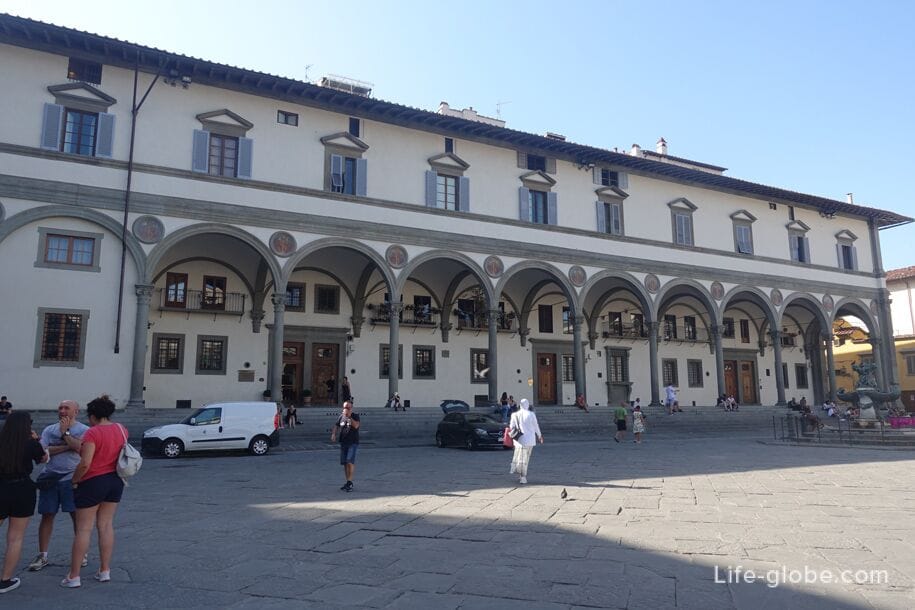
In 1599, a chapel of the Brotherhood of San Girolamo was built here (in the square at number 3). This space was then occupied by the brotherhood of Santa Maria della Pieta, known as Buca di San Girolamo (transferred from the hospital of San Matteo), and from 1911 also by the brotherhood of San Francesco Poverino, whose oratory in via San - Zanobi was destroyed in 1844; the merger of the two fellowships gave rise to the "Venerable Brotherhood of San Girolamo and San Francesco Poverino in San Filippo Benisi".
Numerous works of art and interior items belonging to three companies are still preserved in the chapel, including works by Pseudo Pierfrancesco Fiorentino, Jacopo Vignali, Jacopo da Empoli, Baccio del Bianco, Poppy and others.
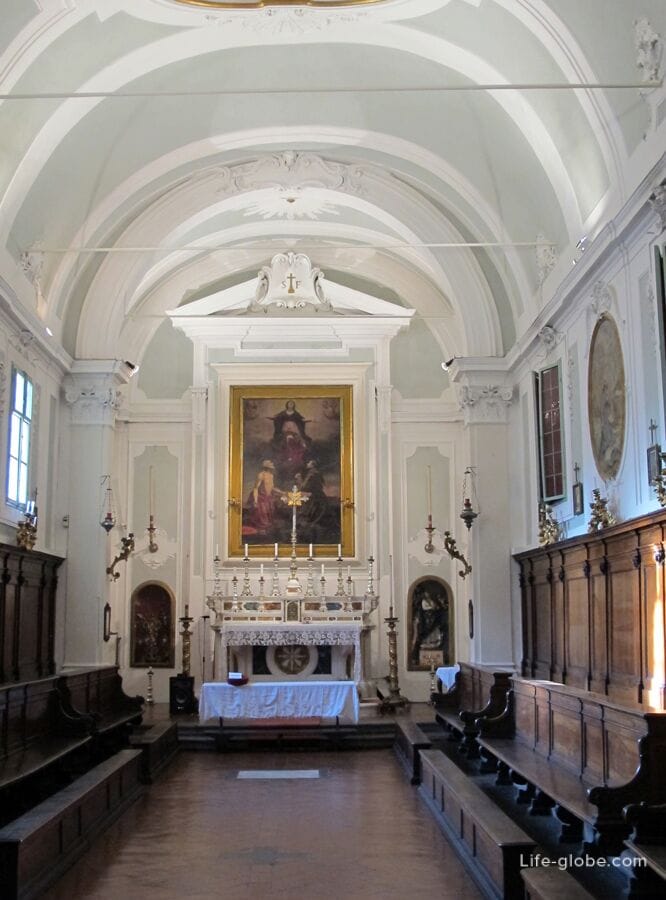
The buildings of the Servants of Mary's Loggia today also house living quarters and accommodation facilities:
3-star hotel Loggiato Dei Serviti
Guest House Residenza d'Epoca Galleria dell'Accademia
Apartments 'Belle Arti' Stunning Apartment!!hosted by Sweetstay
South side of Piazza Santissima Annunziata is formed by two historic palaces.
The Fontane Palace (Palazzo delle Due Fontane), which was most likely an ancient building, but with a rebuilt facade in the neoclassical style between the late nineteenth and early twentieth centuries to provide a suitable backdrop for the square.
The facade of the building is a design of a certain complexity: masonry on the ground floor and architectural decorations on the upper floors.
Today, the building houses the 3-star Hotel Le Due Fontane with free Wi-Fi, a bar and private parking.
The modernly furnished rooms are equipped with a refrigerator, a safe, a minibar, a flat-screen TV with satellite channels. The private bathroom comes with a bidet, hairdryer and free toiletries.
Breakfast is included in the room rate. Link to the hotel
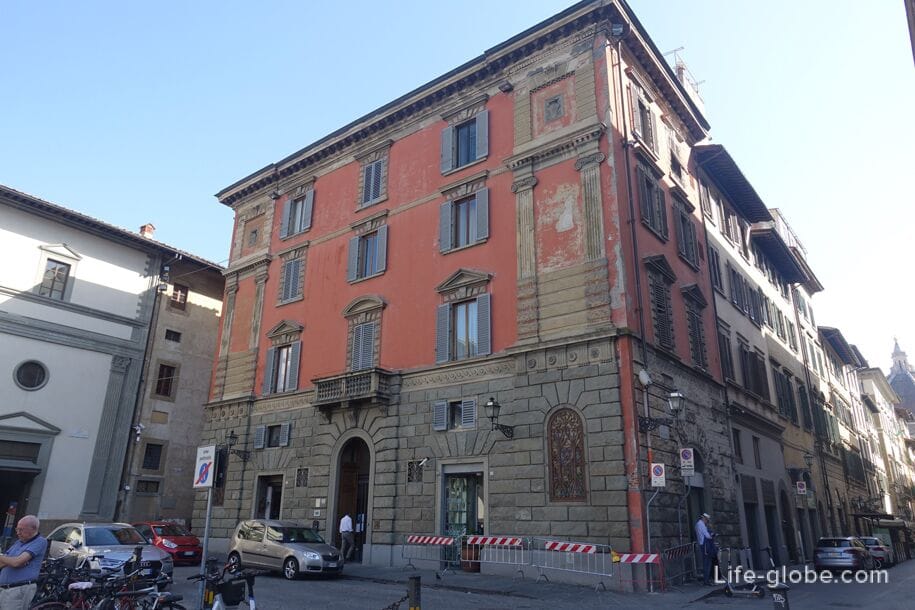
The Grifoni Palace, now the Budini-Gattai Palace (palazzo Grifoni, Palazzo Budini Gattai), which is a masterpiece of Bartolomeo Ammanati, built in the period from 1557 to 1563.
The palace was originally built on the oldest houses of Ricci, then bought by Jacopo Grifoni (known as "Altopacho", secretary of Duke Cosimo I de' Medici) in 1549, who commissioned the rebuilding of the house by the Italian sculptor and architect Bartolomeo Ammanati.
The building had two floors, and the third was built over between the seventeenth and eighteenth centuries. Between 1710 and 1772 there are documented reconstructions and expansions of the property.
During its history, the building changed owners, until in 1889 it passed to the Budini Gattai family. The family reconstructed the building under the direction of architect Giuseppe Boccini (1891-1892): a monumental staircase was created, the street bench at the facades of the building was restored, and the stone decorations and the Griffin coat of arms were largely redone.
The building of solid architecture has three floors and its facade is distinguished by stone decorations, including a pseudo portal, a rich cornice and originally decorated window openings. The arched portal is framed by a halo, above which is a high belt with eulogies with the symbols of Cosimo I (capricorn, turtle with a sail), behind which opens a Serlian window with fluted Ionic columns dominated by the coat of arms of the Griffoni family.
The building has a courtyard and a fountain covered with sponges and shells, possibly by Bartolomeo Ammannati.
An interesting legend is connected with one of the rooms of the palace, which corresponds to the last right window of the upper floor. According to legend, a noblewoman lived here, who was waiting for her beloved to return from the war, sitting sewing in a room by an open window. The man never returned, and the woman remained tied to this room and the view from the window until she died. Having taken away her body after death, someone tried to close the window, but such a noise arose that forced the relatives to open the window again, and since then the window has always remained at least ajar, and the shutters have been raised so that the girl's soul could always look at the square and wait for her lover.
At the origins of the legend, there could be another version based on the fact that the face of Ferdinando I de' Medici, in an equestrian statue standing in front of the palace, is turned directly towards the window of the room of a woman of noble origin Griffoni, who secretly loved Ferdinando and forced her husband to always keep the window open. This is just a legend, because, as can be seen from history, part of the building with this window and room was completed only in the eighteenth century.
Whatever the origin of the legend, and whatever fragment of reality it contains, in fact, the window in question always has at least one shutter ajar.
Behind the Budini-Gattai Palace is a garden with a monumental Mannerist fountain adorned with statues of Venus and sea monsters.
Today, weddings, conferences, corporate events and private parties are held within the walls of the palace and in the garden.
Website: palazzobudinigattai.it.
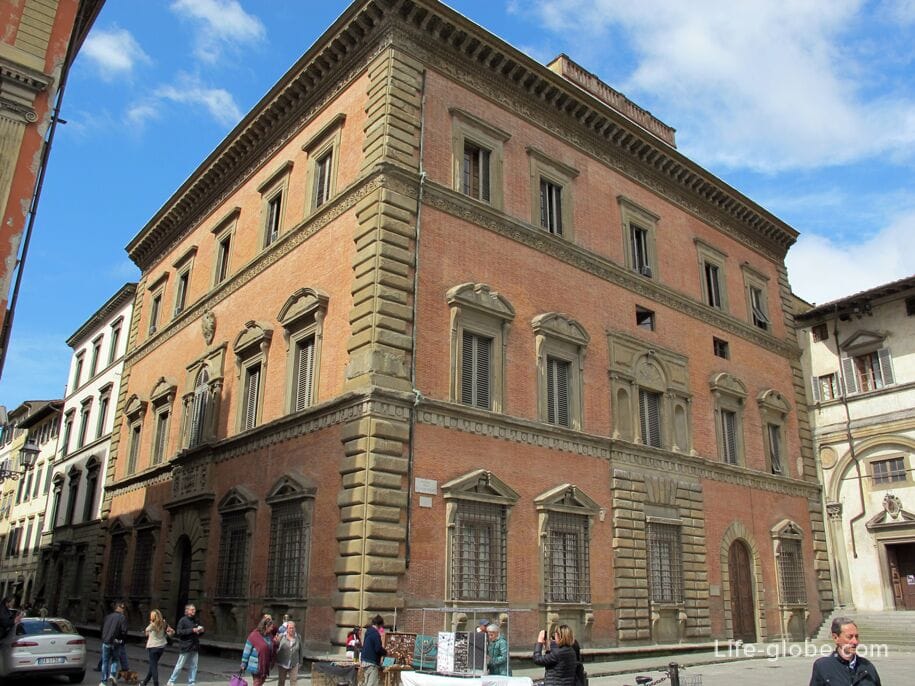
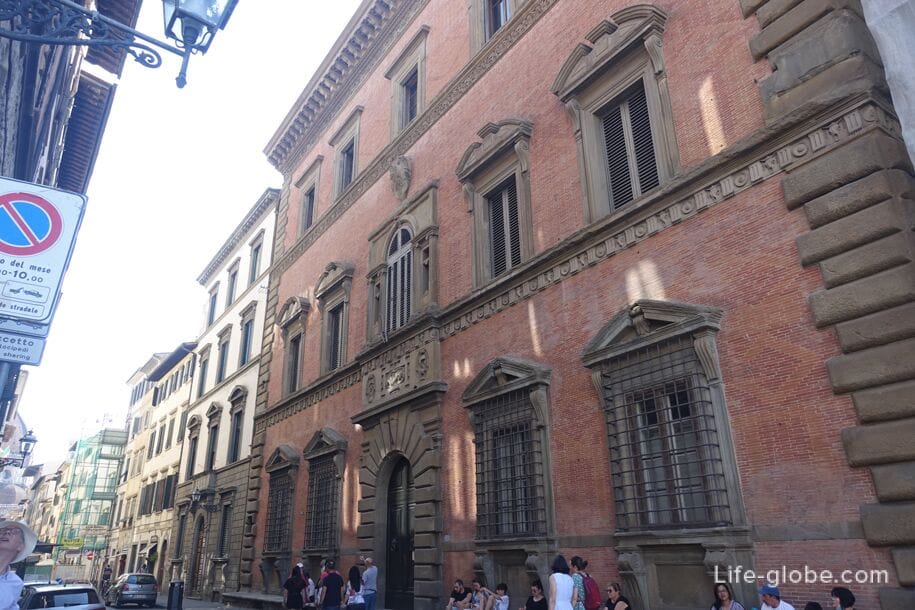
The Santissima Annunziata Square is open to the public 24 hours a day.
Coordinates of the area of Santissima Annunziata: 43°46'35.0"N 11°15'38.5"E (43.776400, 11.260700).
All accommodation facilities in Florence (hotels, apartments, guest houses, etc.), including in the historical center of the city, near the main squares and more remotely from those, can be viewed and booked here